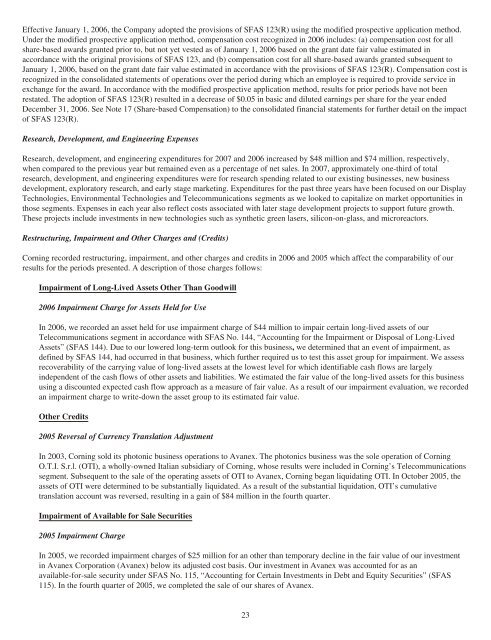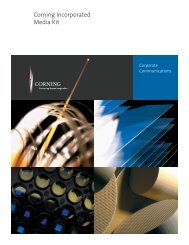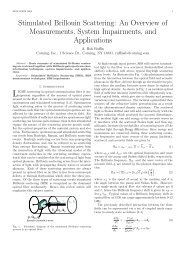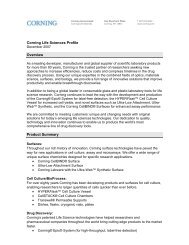Create successful ePaper yourself
Turn your PDF publications into a flip-book with our unique Google optimized e-Paper software.
Effective January 1, 2006, the Company adopted the provisions of SFAS 123(R) using the modified prospective application method.<br />
Under the modified prospective application method, compensation cost recognized in 2006 includes: (a) compensation cost for all<br />
share-based awards granted prior to, but not yet vested as of January 1, 2006 based on the grant date fair value estimated in<br />
accordance with the original provisions of SFAS 123, and (b) compensation cost for all share-based awards granted subsequent to<br />
January 1, 2006, based on the grant date fair value estimated in accordance with the provisions of SFAS 123(R). Compensation cost is<br />
recognized in the consolidated statements of operations over the period during which an employee is required to provide service in<br />
exchange for the award. In accordance with the modified prospective application method, results for prior periods have not been<br />
restated. The adoption of SFAS 123(R) resulted in a decrease of $0.05 in basic and diluted earnings per share for the year ended<br />
December 31, 2006. See Note 17 (Share-based Compensation) to the consolidated financial statements for further detail on the impact<br />
of SFAS 123(R).<br />
Research, Development, and Engineering Expenses<br />
Research, development, and engineering expenditures for <strong>2007</strong> and 2006 increased by $48 million and $74 million, respectively,<br />
when compared to the previous year but remained even as a percentage of net sales. In <strong>2007</strong>, approximately one-third of total<br />
research, development, and engineering expenditures were for research spending related to our existing businesses, new business<br />
development, exploratory research, and early stage marketing. Expenditures for the past three years have been focused on our Display<br />
Technologies, Environmental Technologies and Telecommunications segments as we looked to capitalize on market opportunities in<br />
those segments. Expenses in each year also reflect costs associated with later stage development projects to support future growth.<br />
These projects include investments in new technologies such as synthetic green lasers, silicon-on-glass, and microreactors.<br />
Restructuring, Impairment and Other Charges and (Credits)<br />
<strong>Corning</strong> recorded restructuring, impairment, and other charges and credits in 2006 and 2005 which affect the comparability of our<br />
results for the periods presented. A description of those charges follows:<br />
Impairment of Long-Lived Assets Other Than Goodwill<br />
2006 Impairment Charge for Assets Held for Use<br />
In 2006, we recorded an asset held for use impairment charge of $44 million to impair certain long-lived assets of our<br />
Telecommunications segment in accordance with SFAS No. 144, “Accounting for the Impairment or Disposal of Long-Lived<br />
Assets” (SFAS 144). Due to our lowered long-term outlook for this business, we determined that an event of impairment, as<br />
defined by SFAS 144, had occurred in that business, which further required us to test this asset group for impairment. We assess<br />
recoverability of the carrying value of long-lived assets at the lowest level for which identifiable cash flows are largely<br />
independent of the cash flows of other assets and liabilities. We estimated the fair value of the long-lived assets for this business<br />
using a discounted expected cash flow approach as a measure of fair value. As a result of our impairment evaluation, we recorded<br />
an impairment charge to write-down the asset group to its estimated fair value.<br />
Other Credits<br />
2005 Reversal of Currency Translation Adjustment<br />
In 2003, <strong>Corning</strong> sold its photonic business operations to Avanex. The photonics business was the sole operation of <strong>Corning</strong><br />
O.T.I. S.r.l. (OTI), a wholly-owned Italian subsidiary of <strong>Corning</strong>, whose results were included in <strong>Corning</strong>’s Telecommunications<br />
segment. Subsequent to the sale of the operating assets of OTI to Avanex, <strong>Corning</strong> began liquidating OTI. In October 2005, the<br />
assets of OTI were determined to be substantially liquidated. As a result of the substantial liquidation, OTI’s cumulative<br />
translation account was reversed, resulting in a gain of $84 million in the fourth quarter.<br />
Impairment of Available for Sale Securities<br />
2005 Impairment Charge<br />
In 2005, we recorded impairment charges of $25 million for an other than temporary decline in the fair value of our investment<br />
in Avanex Corporation (Avanex) below its adjusted cost basis. Our investment in Avanex was accounted for as an<br />
available-for-sale security under SFAS No. 115, “Accounting for Certain Investments in Debt and Equity Securities” (SFAS<br />
115). In the fourth quarter of 2005, we completed the sale of our shares of Avanex.<br />
23







